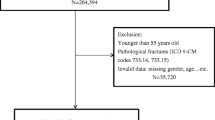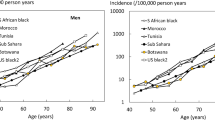Abstract
Introduction
The incidence of hip fracture varies substantially between countries. As a result of improving life expectancy, the number of elderly people susceptible to hip fractures is increasing rapidly in the developing world. Little is known, however, about the epidemiology of hip fractures in the Middle Eastern countries. In this study, our objective was to estimate the incidence of hip fracture in Iran and compare it with other populations.
Methods
The data used were obtained from the Iranian Multicenter Study on Accidental Injuries, a large-scale population-based study conducted in nine provinces across the country. All of the hospitals in these provinces, which provide services to about 9.5 million people, were prospectively surveyed for any incident injury resulting from accidental events occurring in the study period of 135 days (4.5 months). All patients aged ≥50 with radiographically confirmed proximal femur fractures were included in this study. A total of 555 new cases of hip fracture (284 male, 271 female) were recorded during the study period. The annual incidence of hip fracture per 100,000 person-years was 115.2 (95% CI: 107.2–123.7) in men and 115.6 (95% CI: 107.4–124.3) in women; of these,73.2 and 89.2%, respectively, were fall-related fractures. The female-to-male ratios for fall-induced and total hip fracture rates were 1.2 and 1.0, respectively.
Results
The incidence rates increased exponentially after the age of 60 years in both genders and nearly tripled with each successive decade. When these results are compared to those of other studies, the Iranian age-standardized incidence rates of 127.3 (men) and 164.6 (women) per 100,000 person-years are considerably lower than those of all Western countries when standardized to data on the U.S. population in 2000. When compared with incidence rates reported for other Asian countries, those of Iranian females are the lowest next to China.
Conclusion
The low incidence rate of hip fracture for older Iranian women may be the result of several potential factors related to genetic or lifestyle differences between Iranians and people of other countries. Further studies are required to investigate contributing factors in more detail.


Similar content being viewed by others
References
Cummings SR, Kelsey JL, Nevitt MC, O’Dowd KJ (1985) Epidemiology of osteoporosis and osteoporotic fractures. Epidemiol Rev 7:178–208
Schwartz AV, Kelsey JL, Maggi S et al (1999) International variation in the incidence of hip fractures: cross-national project on osteoporosis for the World Health Organization Program for Research on Aging. Osteoporos Int 9:242–253
Lippuner K, von Overbeck J, Perrelet R, Bosshard H, Jaeger P (1997) Incidence and direct medical costs of hospitalizations due to osteoporotic fractures in Switzerland. Osteoporos Int 7:414–425
Wildner M, Clark DE (2001) Hip fracture incidence in east and West Germany: reassessment ten years after unification. Osteoporos Int 12:136–139
Balasegaram S, Majeed A, Fitz-Clarence H (2001) Trends in hospital admissions for fractures of the hip and femur in England, 1989–1990 to 1997–1998. J Public Health Med 23:11–17
Paspati I, Galanos A, Lyritis GP (1998) Hip fracture epidemiology in Greece during 1977–1992. Calcif Tissue Int 62:542–547
Kanis JA, Johnell O, Oden A et al (2000) Long-term risk of osteoporotic fracture in Malmo. Osteoporos Int 11:669–674
Finsen V, Johnsen LG, Trano G, Hansen B, Sneve KS (2004) Hip fracture incidence in central Norway: a follow-up study. Clin Orthop Relat Res 419:173–178
Lofthus CM, Osnes EK, Falch JA et al (2001) Epidemiology of hip fractures in Oslo, Norway. Bone 29:413–418
Melton LJ 3rd, Crowson CS, O’Fallon WM (1999) Fracture incidence in Olmsted County, Minnesota: comparison of urban with rural rates and changes in urban rates over time. Osteoporos Int 9:29–37
Ho SC, Bacon WE, Harris T, Looker A, Maggi S (1993) Hip fracture rates in Hong Kong and the United States, 1988 through 1989. Am J Public Health 83:694–697
Xu L, Lu A, Zhao X, Chen X, Cummings SR (1996) Very low rates of hip fracture in Beijing, People’s Republic of China the Beijing Osteoporosis Project. Am J Epidemiol 144:901–907
Yan L, Zhou B, Prentice A, Wang X, Golden MH (1999) Epidemiological study of hip fracture in Shenyang, People’s Republic of China. Bone 24:151–155
Lau EM, Lee JK, Suriwongpaisal P et al (2001) The incidence of hip fracture in four Asian countries: the Asian Osteoporosis Study (AOS). Osteoporos Int 12:239–243
Hagino H, Yamamoto K, Ohshiro H, Nakamura T, Kishimoto H, Nose T (1999) Changing incidence of hip, distal radius, and proximal humerus fractures in Tottori Prefecture, Japan. Bone 24:265–270
Chie WC, Yang RS, Liu JP, Tsai KS (2004) High incidence rate of hip fracture in Taiwan: estimated from a nationwide health insurance database. Osteoporos Int 15:998–1002
Memon A, Pospula WM, Tantawy AY, Abdul-Ghafar S, Suresh A, Al-Rowaih A (1998) Incidence of hip fracture in Kuwait. Int J Epidemiol 27:860–865
Naghavi M, Jafari N, Alaeddini F, Akbari MS (eds) (2004) Epidemiology of injuries resulting from unintentional accidents, 2nd edn (in Persian). Ministry of Health and Medical Education, Undersecretary for Health, Tehran, Iran
Website: http://www3.who.int/whosis/menu.cfm?path=evidence,burden&language=english; Last access in 5 February 2005
Statistical Center of Iran (2004) Iran statistical yearbook of 2003 (in Persian). Statistical Center of Iran, Tehran, Iran
El Maghraoui A, Koumba BA, Jroundi I, Achemlal L, Bezza A, Tazi MA (2005) Epidemiology of hip fractures in 2002 in Rabat, Morocco. Osteoporos Int 16:597–602
Castro da Rocha FA, Ribeiro AR (2003) Low incidence of hip fractures in an equatorial area. Osteoporos Int 14:496–499
Elffors I, Allander E, Kanis JA et al (1994) The variable incidence of hip fracture in southern Europe: the MEDOS Study. Osteoporos Int 4:253–263
Dennison E, Yoshimura N, Hashimoto T, Cooper C (1998) Bone loss in Great Britain and Japan: a comparative longitudinal study. Bone 23:379–382
Larijani B, Soltani A, Pajouhi M et al (2003) Bone mineral density variation in 20 to 69-years-old population of Tehran-Iran (in Persian). Iran South Med J 1:41–49
Hashemipour S, Larijani B, Adibi H et al (2004) Vitamin D deficiency and causative factors in the population of Tehran. BMC Public Health 4:38
Lips P (2001) Vitamin D deficiency and secondary hyperparathyroidism in the elderly: consequences for bone loss and fractures and therapeutic implications. Endocr Rev 22:477–501
Prior JC, Barr SI, Chow R, Faulkner RA (1996) Prevention and management of osteoporosis: consensus statements from the Scientific Advisory Board of the Osteoporosis Society of Canada. 5. Physical activity as therapy for osteoporosis. Can Med Assoc J 155:940–944
Meyer HE, Falch JA, O’Neill T, Tverdal A, Varlow J (1995) Height and body mass index in Oslo, Norway, compared to other regions of Europe: do they explain differences in the incidence of hip fracture? European Vertebral Osteoporosis Study Group. Bone 17:347–350
Nakamura T, Turner CH, Yoshikawa T et al (1994) Do variations in hip geometry explain differences in hip fracture risk between Japanese and white Americans? J Bone Miner Res 9:1071–1076
Keegan TH, Kelsey JL, King AC, Quesenberry CP Jr, Sidney S (2004) Characteristics of fallers who fracture at the foot, distal forearm, proximal humerus, pelvis, and shaft of the tibia/fibula compared with fallers who do not fracture. Am J Epidemiol 159:192–203
Yan L, Crabtree NJ, Reeve J et al (2004) Does hip strength analysis explain the lower incidence of hip fracture in the People’s Republic of China? Bone 34:584–588
Jacobsen SJ, Goldberg J, Miles TP, Brody JA, Stiers W, Rimm AA (1991) Seasonal variation in the incidence of hip fracture among white persons aged 65 years and older in the United States, 1984–1987. Am J Epidemiol 133:996–1004
Douglas S, Bunyan A, Chiu KH et al (2000) Seasonal variation of hip fracture at three latitudes. Injury 31:11–19
Jacobsen SJ, Sargent DJ, Atkinson EJ et al (1995) Population-based study of the contribution of weather to hip fracture seasonality. Am J Epidemiol 141:79–83
Parker MJ, Twemlow TR, Pryor GA (1996) Environmental hazards and hip fractures. Age Ageing 25:322–325
Boufous S, Finch CF, Lord SR (2004) Incidence of hip fracture in New South Wales: are our efforts having an effect? Med J Aust 180:623–626
Sanders KM, Seeman E, Ugoni AM et al (1999) Age- and gender-specific rate of fractures in Australia: a population-based study. Osteoporos Int 10:240–247
Acknowledgements
This study was supported by a grant from the Ministry of Health and Medical Education of Iran. We would like to thank Dr. N. Jafari and Dr. H. Tavakoli Shalmani for their personal assistance in collecting and analyzing the data. Special thanks are extended to the personnel of the Research Council of the Ministry of Health and Medical Education and all health officials who helped us in conducting this study.
Author information
Authors and Affiliations
Corresponding author
Rights and permissions
About this article
Cite this article
Moayyeri, A., Soltani, A., Larijani, B. et al. Epidemiology of hip fracture in Iran: results from the Iranian Multicenter Study on Accidental Injuries. Osteoporos Int 17, 1252–1257 (2006). https://doi.org/10.1007/s00198-006-0105-2
Received:
Accepted:
Published:
Issue Date:
DOI: https://doi.org/10.1007/s00198-006-0105-2




